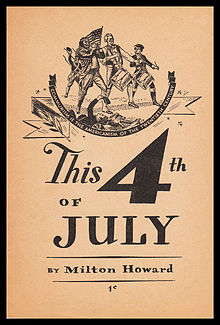Browderism
This served as a revision of the Bolshevik model of communist revolution the party embraced in its early years, seeking a pragmatic approach to present issues.
This shift coincided with Comintern policy under Joseph Stalin, which still supported the popular front strategy worldwide up until the Molotov–Ribbentrop Pact and the beginning of World War II.
These tendencies of Browderism, emphasizing an uncompromising popular front and aim to popularise the party with Americans culminated in 1944, when the CPUSA was officially dissolved for a short time and was restructured into the Communist Political Association.
[5] This decision from Browder, though receiving unanimous support from the National Committee as a constitutional convention for the new organization was planned for May 1944,[6] there was bitter opposition to this change in the form of the Foster-Darcy letter, co-signed by CPUSA factional rival William Z.
Quoting the Foster-Darcy letter, Duclos criticized Browder's beliefs about a harmonious post-war world as "erroneous conclusions in no wise flowing from a Marxist analysis of the situation", and that liquidating the CPUSA constituted a "notorious revision of Marxism".
[11] In retrospect, the article was found by historians Harvey Klehr, John Earl Haynes and Kyrill Anderson to have already been written in Russian and initiated by Moscow, after they determined post-war relations would become hostile.
[19] This strategy was adopted by the Comintern from 1934 until the signing of the Molotov–Ribbentrop Pact in 1939,[4] and popular front governments briefly held power in Spain, France and Chile during the 1930s.
[23] Nonetheless, Browderism sought to incorporate the symbology of mainstream, patriotic culture in order to present communism as a compatible ideology which fits into ideals of freedom and republicanism.
This informed its rejection of non-interventionism during World War II, with Browder supporting Roosevelt moving away from isolationism in the wake of increasing tensions amid the rise of fascism in Europe.
Unlike other variants of Marxism–Leninism like Maoism and Hoxhaism, Browderism has not retained relevance within American communist politics, and did not amass international influence.
It has in retrospect been criticized by anti-revisionists as indicative of American exceptionalism, viewing the circumstances of class struggle and conflict with the bourgeosie as not applying to the United States.
Anti-revisionists also argue that the broad popular front Browderism envisioned subordinated the CPUSA to the interests of the bourgeosie via the Democratic Party, and that the threat of fascism used as justification was non-existent.
[26] Communist Party USA member John Gates called Browderism "a valuable instrument in the hands of U.S. imperialism in its plans for world war and counter-revolution.


